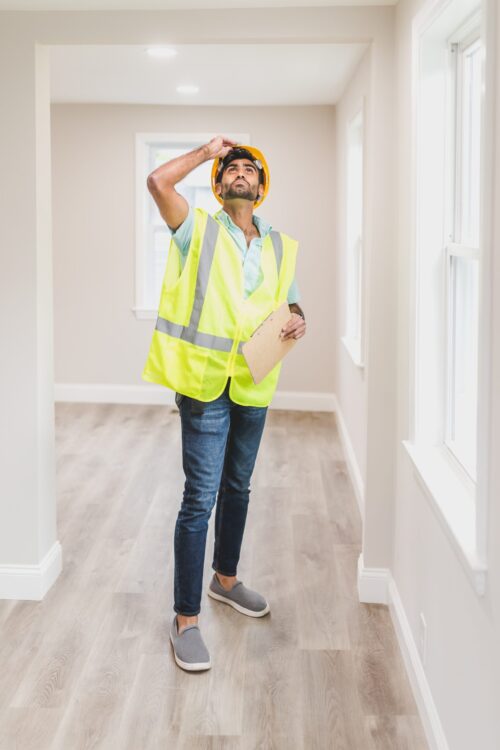One happy-place for the professional contractor and weekend DIY’ers is standing in line waiting to pull a building permit for their upcoming (most likely started and almost finished) construction project. NOT!
Ok perhaps obtaining a building permit for home renovations or construction projects may not be a favourite task, it is however, a necessary task from a safety and statistical standpoint.
In Alberta, the building permit process is based on the Safety Codes Act, Permit Regulation and the Alberta Building Code. The Safety Codes Act is the legislative framework for the development of safety codes and the delivery of safety codes services for municipalities, industry and the public in Alberta. The Act is administered by the province’s Municipal Affairs department with the support of the Safety Codes Council, Alberta Boilers Safety Association, and Alberta Elevating Devices and Amusement Rides Safety Association.
Permits in Alberta are required (by municipal governments?) to be obtained prior to commencing work on any buildings that are covered by the Alberta Building Code and Alberta Fire Code, the Canadian Electrical Code, the Gas Code, or the National Plumbing Code. As the owner of the property, you are responsible to obtain any necessary permits.
Building permits ensure compliance to a minimum standard of construction safety. If a construction project is undertaken without the required permits, you, as the owner, may be subject to penalties and extra costs to bring your project into compliance. However, pulling a permit is not only for your safety, it also provides a glimpse into your economic future.
Building permits are used as a leading economic indicator. They measure the current demand in the real estate market and provide an estimate of the future performance of the construction industry. In addition, they are also used to gauge the strength of the national housing market and the state of the economy in general.
Over the course of the first 20 days of each month, the Building Permits Survey is sent to all approximately 2,400 municipalities in Canada that issue building permits. These municipalities represent approximately 95% of the population of Canada across all provinces and territories. The municipalities that cover the remaining 5% of the population have an insignificant portion of construction activity and thus have very little impact on the overall total.
The Building Permits Survey uses the Generalized Estimation System (G-EST) developed at Statistics Canada to produce its domain estimates. This application produces estimates for domains of a population based on a sample and auxiliary information.
Estimates are computed at several levels of interest such as province and Census Metropolitan Areas (CMA), based on the most recent classification information for the statistical entity and the survey reference period. (Is this para necessary?)
The Building Permits Survey collects data on the value of permits for both residential and non-residential buildings, the number of residential dwellings authorized by the municipality, and the number of dwelling units demolished. Designed to capture basic information included in permits issued by municipalities, such as: permit number, type of project, type of work, value of the work, total building area and the addresses of the builder, the owner and the construction site.
The Building Permit Survey is administered as part of the Integrated Business Statistics Program (IBSP). The IBSP integrates approximately 200 separate business surveys into a single master survey program that collects industry and product details at the provincial level while minimizing overlap between different surveys. This makes reporting easier for firms operating in different industries because they can provide similar information for each branch operation avoiding having to respond to questionnaires that differ for each industry in terms of format, wording and even concepts. The combined results produce more coherent and accurate statistics on the economy.
The statistics from the building permits are essential to a number of different things, such as: the computation of residential building construction expenditures; quarterly and annual estimations of net capital stock, estimating investment in non-residential building construction, and a reference frame for housing starts and completions used by CMHC (Canada Mortgage and Housing) to fulfill its mandate. In addition the building permit statistics are provided by a wide range of economists, construction industry analysts, housing market analysts and economic development officers across Canada.
The statistics are used by banks to determine the demand for mortgage loans on a short-term and medium-term basis, while economists use the number of issued permits as a direct indicator of economic sentiments and construction investments. In other words, the more permits issued, the more economic sentiment, the more construction investment increases.
In November 2021, Alberta’s total value of building permits increased to $1.3 billion, up 20.6% from October. With a small dip to $753 million (-6.6%) in residential building permit values, but a huge increase to $570 million (96%) in non-residential. This huge increase in non-residential growth was led by the $316 million permit approved for the BMO convention centre expansion in Calgary. Slated to open in 2024, the BMO Centre will be over 1 million square feet, the largest convention centre in western Canada.
So the next time you find yourself standing in line waiting to pull a permit, just remember, not only is it for your safety, but you are providing valuable information forming part of a leading indicator of the economy.



